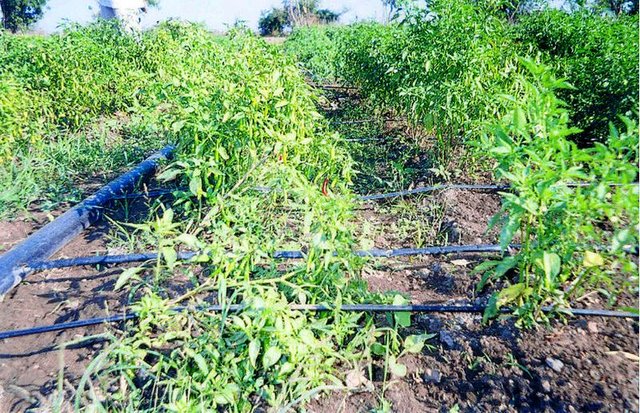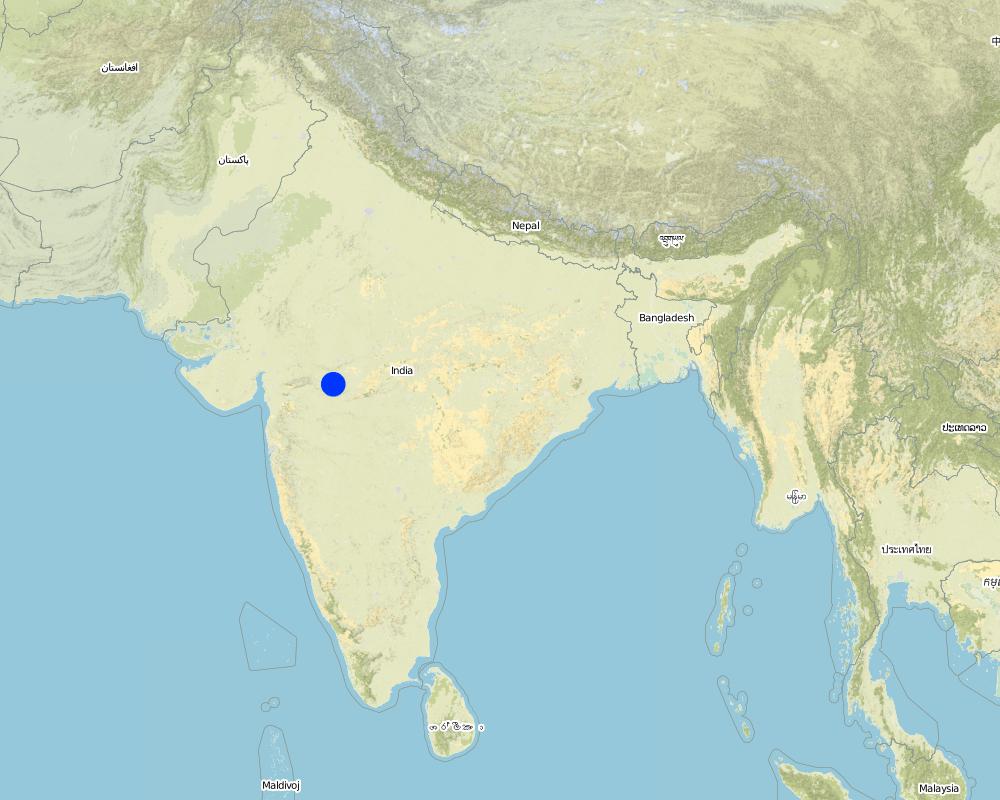Market support and branding for input quality (Krishak Bandhu) [ប្រទេសឥណ្ឌា]
- ការបង្កើត៖
- បច្ចុប្បន្នភាព
- អ្នកចងក្រង៖ Shilp Verma
- អ្នកកែសម្រួល៖ –
- អ្នកត្រួតពិនិត្យច្រើនទៀត៖ Fabian Ottiger, Deborah Niggli
approaches_2369 - ប្រទេសឥណ្ឌា
ពិនិត្យមើលគ្រប់ផ្នែក
ពង្រីកមើលទាំងអស់ បង្រួមទាំងអស់1. ព័ត៌មានទូទៅ
1.2 ព័ត៌មានលម្អិតពីបុគ្គលសំខាន់ៗ និងស្ថាប័នដែលចូលរួមក្នុងការវាយតម្លៃ និងចងក្រងឯកសារនៃវិធីសាស្ត្រផ្សព្វផ្សាយ
អ្នកជំនាញឯកទេស SLM:
Sadangi Amitabha
amitabha@ide-india.org
International Development Enterprises - India
C 5/43, Safdurjang Development Area (1st & 2nd Floor), New Delhi 110016
ដែនដីមហាសមុទ្រឥណ្ឌា ចក្រភពអង់គ្លេស
ឈ្មោះគម្រោងដែលបានចងក្រងឯកសារ/ វាយតម្លៃលើវិធីសាស្ត្រផ្សព្វផ្សាយ (បើទាក់ទង)
Book project: where the land is greener - Case Studies and Analysis of Soil and Water Conservation Initiatives Worldwide (where the land is greener)ឈ្មោះអង្គភាពមួយ (ច្រើន) ដែលបានចងក្រងឯកសារ/ វាយតម្លៃលើវិធីសាស្ត្រផ្សព្វផ្សាយ (បើទាក់ទង)
International Development Enterprises - India (iDE-India) - សហរដ្ឋអាមេរិកឈ្មោះអង្គភាពមួយ (ច្រើន) ដែលបានចងក្រងឯកសារ/ វាយតម្លៃលើវិធីសាស្ត្រផ្សព្វផ្សាយ (បើទាក់ទង)
International Water Management Institute (International Water Management Institute) - ប្រទេសឥណ្ឌា1.3 លក្ខខណ្ឌទាក់ទងទៅនឹងការប្រើប្រាស់ទិន្នន័យដែលបានចងក្រងតាមរយៈវ៉ូខេត
អ្នកចងក្រង និង(បុគ្គលសំខាន់ៗ)យល់ព្រមទទួលយកនូវលក្ខខណ្ឌនានាទាក់ទងទៅនឹងការប្រើប្រាស់ទិន្នន័យដែលបានចងក្រងតាមរយៈ វ៉ូខេត:
បាទ/ចា៎
1.4 ការយោងមួយ (ច្រើន) ទៅលើ (កម្រង) បញ្ជីសំណួរនៃបច្ចេកទេស SLM

Pepsee micro-irrigation system [ប្រទេសឥណ្ឌា]
A grassroots innovation that offers most of the advantages of conventional micro-irrigation at a much lower establishment cost.
- អ្នកចងក្រង៖ Shilp Verma
2. ការពណ៌នាអំពីវិធីសាស្ត្រផ្សព្វផ្សាយ SLM
2.1 ពណ៌នាសង្ខេបខ្លីពីវិធីសាស្ត្រផ្សព្វផ្សាយ
Market development and support through use of a brand name - Krishak Bandhu ('the farmer's friend') - to help ensure quality amongst manufacturers and suppliers of drip irrigation equipment.
2.2 ពណ៌នាលម្អិតពិវិធីសាស្ត្រផ្សព្វផ្សាយ
ពណ៌នាលម្អិតពិវិធីសាស្ត្រផ្សព្វផ្សាយ:
Aims / objectives: Poor smallholder farmers are generally slow in adopting new technologies, especially when such decisions require relatively large initial investments which only yield returns over a long period of time. Even when subsidies are made available, the high transaction costs act as a hindrance. After more than three decades of promotion by government, and despite subsidies as high as 90%, conventional drip irrigation technology remains exclusively popular amongst 'gentlemen' (better-off) farmers in India. Since it was first introduced in the 1970s, the total area under drip irrigation expanded sluggishly from 1,500 ha in 1985 to 225,000 ha in 1998, which is tiny compared to an estimated national potential of 10.5 million hectares.
Methods: IDE, India (IDEI) is an NGO dedicated to troubleshooting such problems through a unique market development approach. IDEI promotes simple, affordable, appropriate and environmentally sound technologies for poor smallholder farmers through private marketing channels, under the brand name Krishak Bandhu. Donor resources are accessed by IDEI to stimulate markets by creating demand for such technologies and by ensuring an efficient supply chain for the equipment. The key to the IDEI approach lies in its adoption and application of commercial business principles as well as in its path of socio-economic development as a tool to sustainability of programmes. IDEI seeks to create a strong and continuing demand by motivating and nurturing an effective supply chain (including manufacturers, dealers and assemblers of micro irrigation equipment). In West Nimar, Madhya Pradesh (as in the whole of India) IDEI supports the marketing of cheap, good quality equipment for so-called 'Affordable Micro-Irrigation Technologies' (AMIT) such as pepsee (see associated technology). The promoted technology in this case is based on a farmer's innovation, which then was promoted and spread by IDEI.
Stages of implementation: IDEI has intervened in four major ways: (1) technically it has further developed the local innovation, pepsee, and come up with an improvement, aptly named 'Easy Drip'; (2) it has promoted small manufacturers of drip irrigation equipment and associated them with a brand name; (3) it has trained and supported private sector 'service providers' to assist farmers to install and adopt the systems; (4) on an ad hoc basis, IDEI commissions and supports studies on uptake and impact. Technologies promoted by IDEI provide returns on investment of at least 100% in one year which is crucial in explaining the success of pepsee. Within five years the projects supported by IDEI should become self-sustaining.
2.5 ប្រទេស/តំបន់/ទីតាំងកន្លែង ដែលវិធីសាស្ត្រផ្សព្វផ្សាយត្រូវបានអនុវត្តន៍
ប្រទេស:
ប្រទេសឥណ្ឌា
តំបន់/រដ្ឋ/ខេត្ត:
Madhya Pradesh
បញ្ជាក់បន្ថែមពីលក្ខណៈនៃទីតាំង:
West Nimar
Map
×2.7 ប្រភេទនៃវិធីសាស្ត្រផ្សព្វផ្សាយ
- ផ្អែកលើគម្រោង/កម្មវិធី
2.8 គោលបំណង/ទិសដៅសំខាន់នៃវិធីសាស្ត្រផ្សព្វផ្សាយ
To bring affordable and appropriate water saving technologies to the rural poor through creating effective supply chains and developing markets, under a brand name associated with reliability.
The SLM Approach addressed the following problems: An underlying problem of increasing growing groundwater scarcity combined with the high investment costs of conventional drip irrigation equipment. On top of this is the reluctance of smallholder farmers to take government subsidies because of the high transaction costs (not easy to access; long delays and the reluctance to adopt new technologies). Local and cheap technological options are available, but quality and marketing channels are not assured.
2.9 លក្ខខណ្ឌអនុញ្ញាត ឬរារាំងការអនុវត្តន៍បច្ចេកទេសដែលស្ថិតនៅក្រោមវិធីសាស្រ្តផ្សព្វផ្សាយ
សង្គម/វប្បធម៌/ និងតម្លៃនៃសាសនា
- រារាំង
Poor consumers are averse to risk and prefer to emulate the success of early-adopters. Hence, there's often a lag period between the introduction of the technology and its poverty impact.
Treatment through the SLM Approach: Every project should become self-sustaining within five years. IDEI therefore establishes the supply chain for manufacturing,IDEI therefore establishes the supply chain for manufacturing,IDEI therefore establishes the supply chain for manufacturing,distri
ភាពអាចរកបាននៃធនធានហិរញ្ញវត្ថុ និងសេវាកម្ម
- រារាំង
Private business decisions are based on profit margins and volumes and the often fragmented and cash-starved customers do not constitute an attractive market on their own.
Treatment through the SLM Approach: IDEI develops and nurtures the market for low-cost smallholder friendly technologies; thereby providing incentives to private businesses by encouraging growth in the size of the market.
ផ្សេងៗ
- រារាំង
economic: Poor consumers cannot make large investments and may even be willing to pay a higher per unit price as long as the one-time investment is lowered.
Treatment through the SLM Approach: IDEI identifies and develops appropriate technologies that have high poverty-alleviation potential, are produced locally; are environment friendly; and provide return on investment of at least 100% in one year.
3. ការចូលរួម និងតួនាទីរបស់ភាគីពាក់ព័ន្ធ
3.1 អ្នកពាក់ព័ន្ធដែលបានចូលរួមក្នុងវិធីសាស្ត្រផ្សព្វផ្សាយ និងតួនាទីរបស់ពួកគេ
- អ្នកប្រើប្រាស់ដីក្នុងតំបន់/សហគមន៍
Smallholder farmers
Traditionally, irrigation investments in particular, and farming in general, has been male-dominated. However, recent studies indicate that women play a critical role in the decision-making process, as these investments often compete with other household requirements.
- អ្នកឯកទេសគ្រប់គ្រងដីប្រកបដោយចីរភាព/ទីប្រឹក្សាបច្ចេកទេសកសិកម្ម
- រដ្ឋាភិបាលថ្នាក់ជាតិ (អ្នករៀបចំផែនការ អ្នកសម្រេចចិត្ត)
- អង្គការអន្តរជាតិ
3.2 ការចូលរួមរបស់អ្នកប្រើប្រាស់ដីក្នុងតំបន់/ សហគមន៍ក្នុងតំបន់ក្នុងដំណាក់កាលផ្សេងគ្នានៃវិធីសាស្រ្តផ្សព្វផ្សាយ
| ការចូលរួមរបស់អ្នកប្រើប្រាស់ដីក្នុងតំបន់/សហគមន៍ក្នុងតំបន់ | សូមបញ្ជាក់នរណាត្រូវបានចូលរួម ព្រមទាំងពណ៌នាសកម្មភាពទាំងនោះ | |
|---|---|---|
| ការចាប់ផ្តើម/ការលើកទឹកចិត្ត | អន្តរកម្ម | |
| ការរៀបចំផែនការ | អសកម្ម | IDEI carrying out awareness creation etc |
| ការអនុវត្តន៍ | អសកម្ម | |
| ការត្រួតពិនិត្យ និងវាយតម្លៃ | អសកម្ម | market surveys, studies, assessments initiated and carried out by IDEI |
| Research | អសកម្ម | planned and carried out by IDEI |
3.3 គំនូសបំព្រួញ (ប្រសិនបើមាន)
ការពណ៌នា:
left: Supply channels of AMIT (Affordable Micro-Irrigation Technologies) systems and the role of IDEI right: Key elements of the AMIT marketing strategy
3.4 ការសម្រេចចិត្តលើការជ្រើសរើសបច្ចេកទេស SLM
សូមបញ្ជាក់តើអ្នកណាជាអ្នកបានសម្រេចចិត្តក្នុងការជ្រើសរើសបច្ចេកទេសដើម្បីយកមកអនុវត្តន៍:
- អ្នកប្រើប្រាស់ដីដោយខ្លួនឯងផ្ទាល់ (គំនិតផ្តួចផ្តើមដោយខ្លួនឯង)
ចូរពន្យល់:
on the basis of their specific requirements.
Decisions on the method of implementing the SLM Technology were made by mainly by land users supported by SLM specialists. Mainly by land users supported by specialists/'service providers' (IDEI, the supporting NGO)
4. ជំនួយបច្ចេកទេស ការកសាងសមត្ថភាព និងការគ្រប់គ្រងចំណេះដឹង
4.1 ការកសាងសមត្ថភាព/ បណ្តុះបណ្តាល
តើវគ្គបណ្តុះបណ្តាលបានផ្តល់ឱ្យអ្នកប្រើប្រាស់ដី/អ្នកពាក់ព័ន្ធផ្សេងៗទៀតដែរឬទេ?
បាទ/ចា៎
ប្រធានបទបណ្តុះបណ្តាល:
Training and extension are combined: while there are no dedicated training courses, through the network of service providers (who have been trained by IDEI), know-how on drip irrigation is spread among adopter and potential adopter farmers. Brochures and pamphlets (several in the local language) are circulated and there is an informative website.
4.3 ការពង្រឹងសមត្ថភាពស្ថាប័ន (ការអភិរឌ្ឍន៍អង្គភាព)
តើស្ថាប័នទាំងអស់ត្រូវបានបង្កើតឡើង ឬពង្រឹងសមត្ថភាពតាមរយៈវិធីសាស្ត្រផ្សព្វផ្សាយដែរ ឬទេ?
- បាទ/ច៎ា បានខ្លាំង
សូមបញ្ជាក់ថាតើស្ថាប័នត្រូវបានពង្រឹង ឬបង្កើតឡើងនៅត្រឹមកម្រិតណា(ច្រើន)?
- ថ្នាក់មូលដ្ឋាន
- see Annex A3
4.4 ការត្រួតពិនិត្យ និងវាយតម្លៃ
តើការត្រួតពិនិត្យ និងវាយតម្លៃគឺជាផ្នែកមួយនៃវិធីសាស្ត្រដែរឬទេ?
បាទ/ចា៎
មតិយោបល់:
bio-physical aspects were regular monitored through measurements; indicators: improvement in water-use efficiency
technical aspects were regular monitored through measurements; indicators: appropriateness of the technology to different crops and locations; also trying out technologies with new crops
socio-cultural aspects were regular monitored through observations; indicators: impact on women and on the poor
economic / production aspects were regular monitored through measurements; indicators: returns vis-à-vis investments
area treated aspects were regular monitored through measurements; indicators: total scale of adoption; IDEI's estimates suggest that their technologies have so far reached 30'000 families
There were None changes in the Approach as a result of monitoring and evaluation: IDEI carries out a number of studies to investigate the impact of their technologies and the scale and dynamics of adoption. The results of these studies feed into their strategic and operational plans. For example, IDEI was the first to introduce drips in mulberry cultivation in Kolar. That became a huge success story.
4.5 ការស្រាវជ្រាវ
តើការស្រាវជ្រាវ គឺជាផ្នែកមួយនៃវិធីសាស្រ្តដែរឬទេ?
បាទ/ចា៎
សូមផ្តល់ព័ត៌មានបន្ថែមទៀតឱ្យបានលម្អិត និងចង្អុលបង្ហាញនរណាដែលបានធ្វើការស្រាវជ្រាវ:
Apart from research carried out by scientists (published in journals etc) IDEI has its own series of research reports which present the results of various studies on promotion and impact of low cost water saving technologies conducted (see references).
5. ថវិកា និងសម្ភារៈឧបត្ថម្ភពីខាងក្រៅ
5.1 ថវិកាប្រចាំឆ្នាំសម្រាប់ផ្សព្វផ្សាយ SLM
មតិយោបល់ (ឧ. ប្រភពសំខាន់នៃមូលនិធិ/ម្ចាស់ជំនួយចំបង):
Approach costs were met by the following donors: international non-government (Donor agencies): 100.0%
5.2 ការគាំទ្រផ្នែកហិរញ្ញវត្ថុ / សម្ភារៈដែលបានផ្តល់ទៅឱ្យអ្នកប្រើប្រាស់ដី
តើអ្នកប្រើប្រាស់ដីបានទទួលការគាំទ្រផ្នែកហិរញ្ញវត្ថ/សម្ភារៈសម្រាប់ការអនុវត្តន៍បច្ចេកទេសដែរឬទេ:
ទេ
5.3 សូមបញ្ជាក់ពីធាតុចូលត្រូវបានផ្តល់បដិភាគ (រួមទាំងកម្លាំងពលកម្ម)
- គ្មាន
ប្រសិនបើកម្លាំងពលកម្មធ្វើដោយអ្នកប្រើប្រាស់ដី តើវាជាធាតុចូលដ៏សំខាន់មួយដែរ ឬទេ:
- ដោយស្ម័គ្រចិត្ត
មតិយោបល់:
No incentives to support labour are given to land users. IDEI supports the whole chain from manufacturers and dealers to assemblers
5.4 ឥណទាន
តើឥណទានដែលបានផ្តល់នៅក្រោមវិធីសាស្ត្រផ្សព្វផ្សាយសម្រាប់សកម្មភាព SLM នេះយ៉ាងដូចម្តេច?
ទេ
6. ការវិភាគរកផលប៉ះពាល់ និងសេចក្តីសន្និដ្ឋាន
6.1 ផលប៉ះពាល់នៃវិធីសាស្ត្រផ្សព្វផ្សាយ
តើវិធីសាស្ត្រផ្សព្វផ្សាយជួយអ្នកប្រើប្រាស់ដីដើម្បីអនុវត្តន៍ និងថែទាំបច្ចេកទេស SLM?
- ទេ
- បាទ/ច៎ា បន្តិចបន្តួច
- បាទ/ច៎ា ជាមធ្យម
- បាទ/ច៎ា បានខ្លាំង
The widespread adoption of the pepsee and Easy Drip irrigation infrastructure has greatly improved water use efficiency
6.3 សកម្មភាពផ្សព្វផ្សាយដែលប្រកបដោយចីរភាព
តើអ្នកប្រើប្រាស់ដីអាចធ្វើឱ្យមានចីរភាពនូវអ្វីដែលត្រូវបានអនុវត្តន៍តាមរយៈវិធីសាស្ត្រផ្សព្វផ្សាយដែរឬទេ(ដោយពុំមានការគាំទ្រពីអ្នកខាងក្រៅ)?
- មិនប្រាកដ
ប្រសិន ទេ ឬមិនប្រាកដសូមបញ្ជាក់ និងពន្យល់:
Entire approach relies on creation of markets which are initially promoted and supported by IDEI. Too early to say whether the market would be sustained after IDEI withdraws but because of the fact that pepsee was a grassroots innovation and emerged spontaneously, there is a good chance. IDEI keeps a five year horizon for its intervention, and targets that market becoms self-sustaining afterwards.
6.4 ភាពខ្លាំង/ គុណសម្បត្តិនៃវិធីសាស្ត្រផ្សព្វផ្សាយ
| ភាពខ្លាំង/ គុណសម្បត្តិ/ ឱកាស ទស្សនៈរបស់បុគ្គលសំខាន់ៗ |
|---|
| IDEI believes in the essential dignity of people and their capacity to overcome social and economic pressures, problems and exploitations. It therefore treats poor farmers as customers and not recipients of charity. It applies business models to achieve development by tapping and developing small enterprises in the rural economy and creating markets. |
| It applies business models to achieve development by tapping and developing small enterprises in the rural economy and creating markets (How to sustain/ enhance this strength: Further promote market creation and then let the market forces take off on their own.) |
| The IDEI market creation approach to development ensures that there is awareness and availability of low-cost products that will have a high poverty alleviation impact (How to sustain/ enhance this strength: Ditto) |
| Growth in this approach will take place if the supply chain is performing and profitable. The early adopters may not be the poorest but if the product meets the needs of the farmers, the rural poor will follow suit and considerable market growth could result, creating a sustainable supply channel (How to sustain/ enhance this strength: Ditto) |
6.5 ភាពខ្សោយ/ គុណវិបត្តិនៃវិធីសាស្ត្រ និងរកដំណោះស្រាយ
| ភាពខ្សោយ/ គុណវិបត្តិ/ ហានិភ័យ ទស្សនៈរបស់អ្នកប្រើប្រាស់ដី | តើបច្ចេកទេសទាំងនោះបានដោះស្រាយបញ្ហាដូចម្តេច? |
|---|---|
| IDEI needs to work more closely with the government agencies. While market creation seems to be a very useful model, it needs to tap the government resources which are pumped every year in the business of promotion of drip irrigation. |
| ភាពខ្សោយ/ គុណវិបត្តិ/ ហានិភ័យក្នុងទស្សនៈរបស់បុគ្គលសំខាន់ៗ | តើបច្ចេកទេសទាំងនោះបានដោះស្រាយបញ្ហាដូចម្តេច? |
|---|---|
| IDEI's reach is dependent on its ability to access donor funds. This might become a limitation at some stage. |
7. ឯកសារយោង និងវេបសាយ
7.1 វិធីសាស្ត្រ/ ប្រភពនៃព័ត៌មាន
- តាមការចុះទីវាល ការស្រាវជ្រាវនៅទីវាល
- ការសម្ភាសន៍ជាមួយអ្នកប្រើប្រាស់ដី
7.2 ឯកសារយោងដែលបានចេញផ្សាយ
ចំណងជើង អ្នកនិពន្ធ ឆ្នាំ ISBN:
IDEI Affordable Micro Irrigation Technologies: Marketing Manual. International Development Enterprises, USA.Phansalkar, S.J. (2003). Appropriate Drip Irrigation Technologies Promoted by IDEI: A Socio-Economic Assessment. International Development Enterprises, India (IDEI),Verma, S., Tsephal, S. and Jose, T. (2004). Pepsee Systems: Grassroots Innovation under Groundwater Stress. Water Policy,
ចំណងជើង អ្នកនិពន្ធ ឆ្នាំ ISBN:
Phansalkar, S.J. (2003). Appropriate Drip Irrigation Technologies Promoted by IDEI: A Socio-Economic Assessment. International Development Enterprises, India (IDEI),
ចំណងជើង អ្នកនិពន្ធ ឆ្នាំ ISBN:
Verma, S., Tsephal, S. and Jose, T. (2004). Pepsee Systems: Grassroots Innovation under Groundwater Stress. Water Policy,
ការតភ្ជាប់ និងម៉ូឌុល
ពង្រីកមើលទាំងអស់ បង្រួមទាំងអស់ការតភ្ជាប់

Pepsee micro-irrigation system [ប្រទេសឥណ្ឌា]
A grassroots innovation that offers most of the advantages of conventional micro-irrigation at a much lower establishment cost.
- អ្នកចងក្រង៖ Shilp Verma
ម៉ូឌុល
គ្មានម៉ូឌុល



